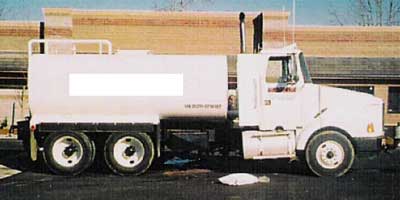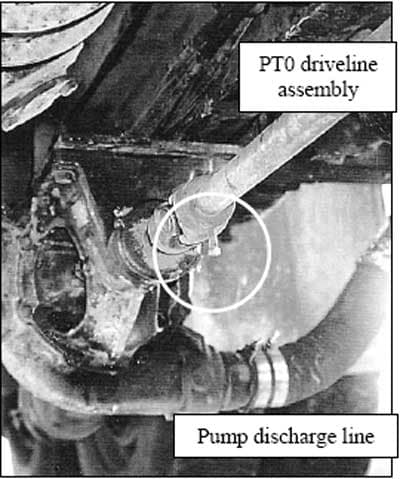Mechanic Killed when Collar Caught on PTO Driveline
Oregon Case Report: 06OR005
November 27, 2006
Summary
On February 9, 2006, a 33-year-old field mechanic was killed while repairing a 1989 Volvo water truck at a customer’s construction site. The mechanic was dispatched to diagnose and repair a malfunction of the truck’s water spray system. Working underneath the truck, the mechanic discovered a kink in the water discharge hose, which he fixed. After moving his tools out of the way, he went underneath the truck again while it was running. While he was underneath the rear undercarriage of the water truck, with a 21 in. clearance, a protruding set screw on the power take-off drive shaft that runs the truck’s water pump caught on the collar of his coveralls and entangled his coveralls and shirt. His head was pulled against the rapidly rotating shaft, causing massive trauma. The water truck driver and construction site supervisor heard a noise and saw the victim fall when his clothing tore free. The victim was declared dead shortly after arrival at a hospital.

|
| A field mechanic was apparently checking his repair work underneath this water truck when his collar caught and tangled in the rotating power take-off drive shaft. |
Recommendations
- Prior to performing maintenance operations on any machine, make sure to de-energize, isolate, and block all forms of hazardous energy.
- Do not crawl under, on, or over unguarded power take-off (PTO) drivelines while the PTO is operating.
- Equipment should be designed or retrofitted to shield any open, unguarded power take‑off drivelines.
- Employers should develop and implement a comprehensive safety program that includes training in hazard recognition and avoidance for all tasks that may expose workers to the release of hazardous energy.
Introduction
On Thursday, February 9, 2006, a 33-year-old equipment field mechanic was fatally injured when the collar of his coveralls got caught by a protruding set screw on a rotating power take-off (PTO) driveline under a water truck, pulling his head against the rotating shaft. OR-FACE was informed of the incident on February 9 by Oregon OSHA. The employer did not respond to OR‑FACE requests for an interview. This report is based on information from Oregon OSHA and medical examiner reports.
The non-union employer is a large Oregon equipment sales and service dealer of construction and forestry equipment, in business since 1938, with 37 locations in seven western states, including 6 locations in Oregon. The dealer has over 100 workers in Oregon, employing 19 at the sales/service location where the field mechanic worked.
The employer has written safety, and energy isolation/lockout programs, as well as a safety committee that conducts inspections and participates in the safety and health management program coordinated by a corporate safety and health manager. Each location’s service manager is responsible for periodic lockout inspections and recordkeeping. The firm’s written Hazardous Energy Control – Lockout/Tagout program provides for isolation of all equipment being worked on, periodic inspections, contractor notification, and lockout sequence procedures. The generic program does not specify procedures for each task, such as performing diagnostics under operating vehicles or working in close proximity of unguarded power take-off shafts. Although lockout training had been held the prior year at the service location employing the victim, field inspections were not being performed at the time of the incident.
The construction company in charge of the water truck in this incident also had a written energy isolation program with lockout procedures. The dealership and the construction contractor had not informed each other of their respective energy isolation procedures, as specified in both of their written programs.
Field mechanics diagnose and repair equipment at the customer’s sites. Repairs may include welding, repairing, replacing or rebuilding the equipment’s motors, hydraulics, pumps, steering, drivelines, electrical, and other systems. The technician in this incident, who had 13 years of experience, had been employed with the dealership for 22 months as a field service mechanic.
Investigation
The field mechanic was dispatched to the construction site to diagnose and repair a malfunction of a water-spray system on a water truck. The truck’s water valve system had been repaired at the equipment dealer’s repair shop, and was picked up that morning by the construction company driver and taken to the construction site. The driver and the construction site supervisor tried to spray down a new parking lot at the site, but the water hose did not function properly. The field mechanic arrived at the site and began his diagnostics under the truck. The driver then left to move a different truck to another location.
Upon the driver’s return, he found the water truck had been moved to another area and had been worked on. The mechanic told the driver that the problem was a kink in the water discharge hose, and he crawled under the truck and began working on the discharge system’s metal pipe nipple and hose. The driver left the area to help the construction site supervisor move material onto a truck.
The mechanic apparently fixed the kinked hose and moved his tools out from under the truck. The tools were later found several feet from the truck. The mechanic then went underneath the truck again with the PTO driveline operating.
The 1989 Volvo truck was equipped with an unguarded 32½ in. power take off (PTO) driveline on the rear undercarriage of the vehicle, transferring power from the truck’s engine to the water pump. The driveline is fitted with a smooth metal collar held in position by a 3/8 in. diameter set screw that projects from the collar by 1 in. The driveline rotates at about 1600 rpm, with a 21 in. clearance between the turning shaft and the roadbed.
While he was underneath the rear undercarriage of the water truck, the collar of the field mechanic’s coveralls caught on the protruding set screw on the PTO driveline, which entangled his coveralls and shirt. His head was pulled against the rapidly rotating shaft, causing massive trauma as the set screw repeatedly struck him on the back of his head and neck.
About 10 minutes after leaving the area, the construction company driver and site supervisor heard a noise above the water truck’s engine noise. They turned and saw the victim fall from under the water tank’s operating power driveline as his clothing tore free. They found the victim face down and nonresponsive. The driver shut off the engine and the site supervisor called 911. Police and emergency medical services arrived to aid the victim and control the scene. The victim died after arriving at the hospital emergency room.
 |
| On the rear undercarriage of the water truck, the protruding set screw can be seen on the PTO driveline, near the U‑joint connection, which caught the collar of the victim’s coveralls and entangled him. |
Cause of Death
Severe head and neck trauma
Recommendations/Discussion
Recommendation #1: Prior to performing maintenance operations on any machine, make sure to de-energize, isolate, and block all forms of hazardous energy.
This standard safety rule includes turning off motors and removing keys from vehicles and heavy equipment.
Recommendation #2. Recommendation #2. Do not crawl under, on, or over unguarded power take-off (PTO) drivelines while the PTO is operating.
Power take-off equipment operates at high speeds to transfer power from construction and agricultural equipment engines to auxiliary implements, such as pumps, plows, augers, winches, and irrigation equipment. PTO-related injuries are generally severe, most often resulting in badly broken bones, amputations, scalping, disfigurement, or death. Stay away from the PTO! Keep close control of hair, shoestrings, and all clothing when working near a PTO driveline. Avoid areas near a moving unguarded PTO driveline.
Recommendation #3. Equipment should be designed or retrofitted to shield any open, unguarded power take-off drivelines.
Power take-off equipment should be properly fitted with guards that fully enclose the entire exposed driveline. The guard should enclose all power take‑off stubs, driveline collars, and any protruding bolts, pins, or set screws. Kits are available to retrofit shields on older equipment.
Unguarded PTO drivelines are especially hazardous. Numerous catastrophic injuries and fatalities continue to be reported in relation to unguarded PTO drivelines. Another recent FACE case (MI‑FACE #03MI052) reported entanglement on a protruding bolt on an unguarded PTO driveline, similar to the incident here.
Although most PTO driveline assemblies are now manufactured with full shields, repair work or damage often leave a driveline exposed; or the driveline may be intentionally exposed for operator convenience. One survey of agricultural equipment found damaged or missing shielding on about 40% of the PTO drivelines observed. A driveline under a truck, where it is supposedly inaccessible, is most likely to lack a full shield. Never assume a PTO driveline is safe. Inspect and repair guards before ever working around an operating PTO. Never take a PTO for granted. Always remember and guard against the extreme hazard – beforehand.
Recommendation #4: Employers should develop and implement a comprehensive safety program that includes training in hazard recognition and avoidance for all tasks that may expose workers to the release of hazardous energy.
Employee training should include standard operating procedures to be followed while working on or under vehicles and equipment, such as performed by field maintenance mechanics, who frequently work alone. All hazardous energy programs must include authorization to perform lockout/tag out procedures on machinery for all affected workers, with documented training and periodic inspections. Employers and contractors must advise one another and all affected workers of their respective hazardous energy procedures.
References
- Beer, S.R. & Field, W.E. (2005). Analysis of factors contributing to 674 agricultural driveline‑related injuries and fatalities documented between 1979 and 2003. Journal of Agromedicine, 10(3), 3-19.
- Michigan Fatality Assessment and Control Evaluation. Farm youth died when he became entangled in an unguarded PTO shaft. National Institute for Occupational Safety and Health. Available online: www.cdc.gov/niosh/face/stateface/mi/03mi052.html
- National Agricultural Safety Database. Search “PTO.” Online resource: www.nasdonline.org/index.htmlexternal icon (Link updated 8/5/2009)
- National Institute for Occupational Safety and Health. Search “PTO.” Online resource: www.cdc.gov/niosh/face/
- National Safety Council. Power Take-Off (PTO) Safety. Available online: www.nsc.org/library/facts/agripto.htm (link no longer available)
Oregon FACE Program
To contact Oregon State FACE program personnel regarding State-based FACE reports, please use information listed on the Contact Sheet on the NIOSH FACE web site. Please contact In-house FACE program personnel regarding In-house FACE reports and to gain assistance when State-FACE program personnel cannot be reached.
CROET at OHSU performs OR-FACE investigations through a cooperative agreement with the National Institute for Occupational Safety and Health (NIOSH), Division of Safety Research. The goal of these evaluations is to prevent fatal work injuries in the future by studying the work environment, the worker, the task, the tools, the fatal energy exchange, and the role of management in controlling how these factors interact.
Oregon FACE reports are for information, research, or occupational injury control only. Safety and health practices may have changed since the investigation was conducted and the report was completed. Persons needing regulatory compliance information should consult the appropriate regulatory agency.

